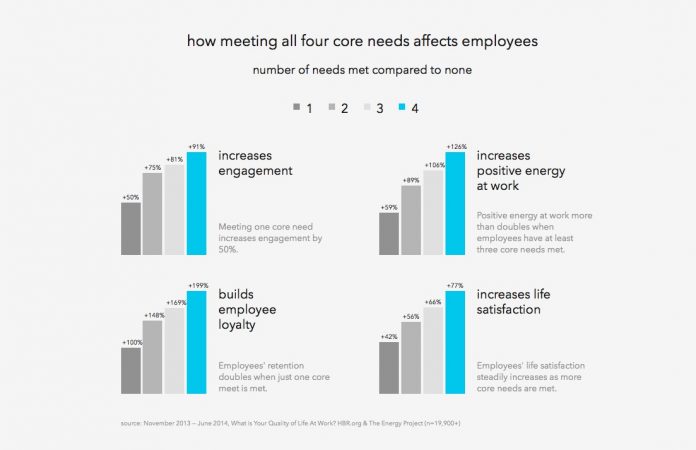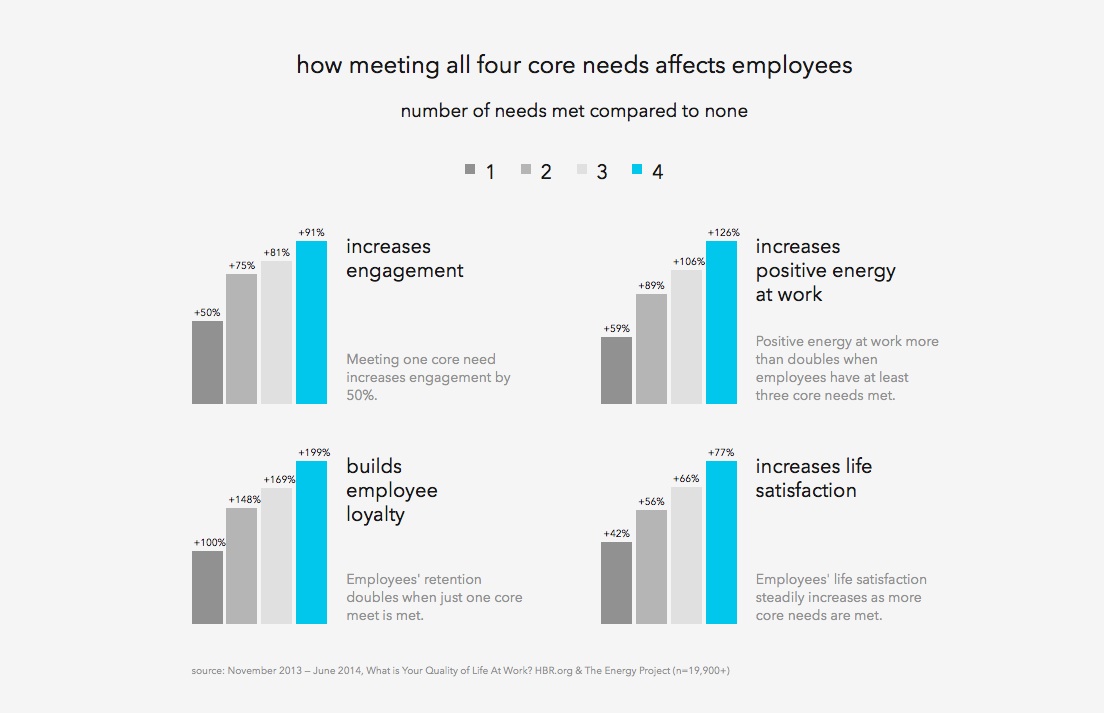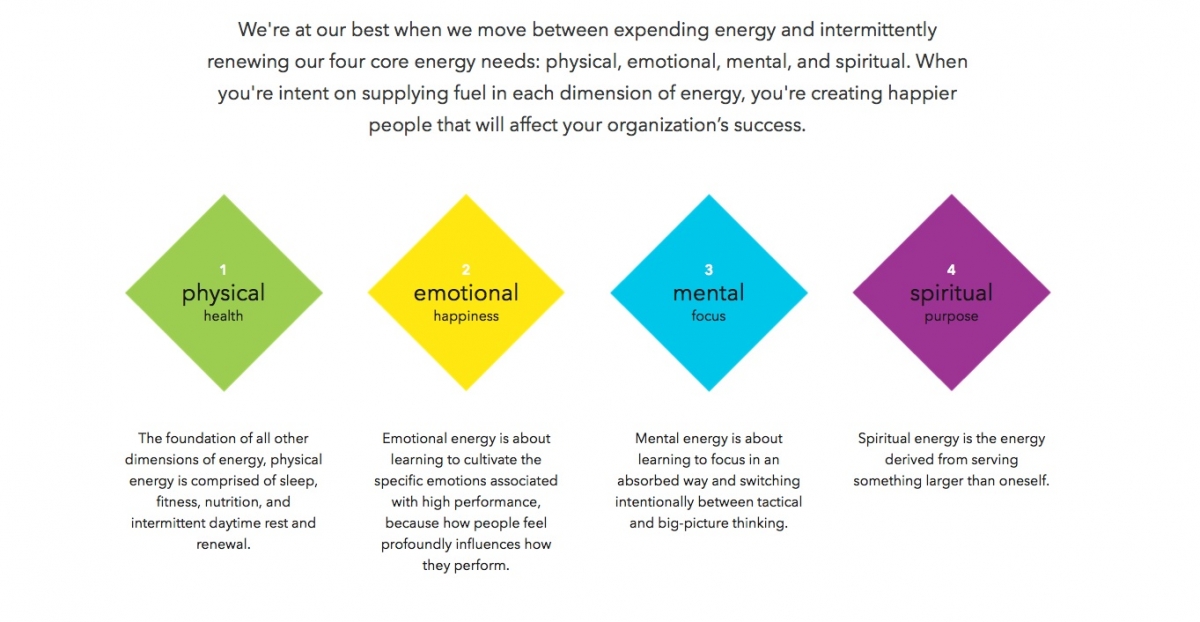
The beleaguered employee staying at the office until 8 p.m. or later every night, who hasn’t gotten a raise or recognition in years and yet still keeps going, is a familiar image in corporate America. With a slowly recovering economy and greater demands on workforces, more strain has been put on employees.
A recent study and initiative, The Energy Project (theenergyproject.com), turned the spotlight on the need to guard against workforce burnout. Some 59 percent of workers are physically depleted, emotionally drained, mentally distracted, and lacking in meaning and purpose, according to the study, “What Is Your Quality of Life at Work?” of 19,900-plus respondents by HBR.org and The Energy Project. “We’re at our best when we move between expending energy and intermittently renewing our four core energy needs: physical, emotional, mental, and spiritual,” the study concluded. “When you’re intent on supplying fuel in each dimension of energy, you’re creating happier people who will affect your organization’s success.”


Note: Graphics can be downloaded at the end of the article.
Here, Training Top 10 Hall of Fame member Booz Allen Hamilton and pharmaceutical products development firm and Training Top 125er PPD offer their guidance on reenergizing your employees.
HOLISTIC EMPLOYEE DEVELOPMENT
“At Booz Allen, we recognize the whole person. We draw on best practices and extensive research to understand engagement, personal energy, and high performance,” says Nancy NeJame, lead associate at Booz Allen Hamilton. “We see engagement as a partnership and provide a variety of resources and opportunities for employees at all levels to leverage, including but not limited to, coaching, training, and wellness programs.”
Common signs of employee burnout, NeJame says, include exhaustion, lack of motivation, frustration, cynicism, irritability, negativity, difficulty paying attention, and reduced job performance. “The company is attentive to the impact the office environment can make on feelings of burnout,” she explains, “so Booz Allen offers staff opportunities to fuel their health with treadmill and standing desks, walking meetings, and generous health and wellness benefits.”
USE TRAINING TO MAINTAIN ENGAGEMENT
Generous development opportunities go a long way to creating engaged employees, NeJame adds. “Booz Allen supports staff development through benefit programs, tuition and certification reimbursement programs, robust training programs, sponsorship and mentoring programs, rotational assignments, and targeted functional training programs in areas of high impact.” NeJame explains that these programs drive engagement by allowing staff to learn new skills in their field of interest, prepare for new roles, explore innovation solutions to business challenges, and lead efforts for improvement and change. “When staff members are empowered to pursue the growth opportunity that appeals to them, they are more likely to stay engaged and energized.”
SOLICIT EMPLOYEE FEEDBACK
Booz Allen has adopted a performance management model that encourages feedback conversations throughout the year. “This model shifts the focus from annual development to a regular dialogue around successes, as well as opportunities to develop in real time. Shifting the focus away from an annual performance review and to a consistent conversation about goals and development allows employees to stay engaged and to course correct,” NeJame says. “Staff report that having the opportunity to engage with their leadership to identify and tailor performance goals allows for impactful work and growth assignments—and engagement.”
TRAIN ON DELEGATION
Pharmaceutical product development firm PPD keeps an open dialogue with employees on the demands of their work, and also encourages them to delegate, says Executive Director of Organizational Effectiveness Lynn Whitesell. “One specific strategy we’ve found helpful in addressing, and even avoiding, burnout is to not only encourage our leaders to delegate, but also to encourage them to foster a development culture in their organizations, so that delegation is possible,” she says. “We support this culture with ample skills-based professional development and leadership development programs.”
A development culture requires that before senior leaders take on a new task, assignment, or role, they must delegate one task to a leader on their team, Whitesell explains. It must be a task the senior leader is no longer learning or growing from doing, and one from which the new owner would get enrichment. Prior to new leaders taking on a delegated task, they also must first delegate a task to a team member, within similar parameters. This approach, she notes, can cascade several layers into an organization. “It often leads to process improvement—the discontinuation of tasks that are no longer adding value, but are being done solely because they always have been,” says Whitesell. “This process results in three things key to engagement: continuing growth and development for all, decreased risk of burnout for all, and frequent process improvement.”
ENABLE HORIZONTAL AND VERTICAL GROWTH
Whitesell says providing opportunities for employees to both gain greater experience at their current level, as well as advance to the next level, is crucial to thwarting burnout. “We provide programs that enable employees to grow horizontally and vertically. We must provide them multiple types of training and development to do their jobs successfully, to gain skills and experience in preparation to take on new responsibilities, to grow personally and professionally,” she says, pointing to the company’s technical job skills training, soft skills training, various levels of training for individual contributors, leadership training, targeted talent programs, and mentoring opportunities.
SHOW THEM THE ROAD AHEAD
It’s easy to feel burned out when you can’t see the road ahead of you at a company—when you can’t see past each day’s tasks toward a larger goal or stepping stone. A key to keeping an energized and engaged workforce, says Whitesell, is creating a longterm development plan that shows each employee the path to growth and achievement that is possible if they stick with the company and continue performing well. “During onboarding, we introduce our new employees to the many learning and development opportunities they will have throughout their careers at PPD,” says Whitesell. “We clearly show new employees that we have programs to support and grow them throughout a long career at PPD.
QUICK TIPS
- Take a holistic approach to development that recognizes psychological and health and wellness needs, in addition to hard and soft skills training.
- Provide tuition or professional certification support to enable employees to grow in their field of interest or try something new.
- Encourage employee feedback conversations throughout the year in which the employee can express challenges and provide additional resources that might help.
- Train leaders and managers to delegate tasks whenever appropriate, and to develop those under them with these assignments.
- Provide cross-training opportunities, as well as upward advancement opportunities.
- Offer a comprehensive development plan that shows employees the light at the end of the tunnel—what they get if they do a good job and stick with the company long-term.
BOOST YOUR ENERGY
By David Sturt, Executive Vice President, O.C. Tanner Institute; author, “Great Work: How to Make a Difference People Love,” and Forbes.com columnist (follow him: @david_sturt)
Helping your organization stay ahead of the competition, expand to new markets, and meet financial targets takes dedicated and engaged employees. Here are three key tips for energizing your workforce to reach that next milestone:
1. INTRODUCE THEM TO THE CUSTOMER. Of all the skills that are likely to produce great work, the act of having employees “see for themselves” how their work influences others has the greatest impact—employees are 17 times more likely to develop passion for their work. Encourage employees to visit with customers and see how they experience your products and services. They then can imagine what can be improved. But don’t stop there. Apply the same concept of going and seeing to work processes in order to understand how work is conceived, produced, and delivered. Additionally, spending some time away from the office allows people to “see for themselves” ideas from nature, sports, and the arts and sciences, and to explore what other disciplines can bring to your team. “Seeing for yourself” will stir passion in your employees.
2. CONNECT THEM WITH OTHERS. Find opportunities to help employees interact with people outside their normal circle of trust. We call this “talking to your outer circle,” and it’s a great way to spur innovative ideas and creative solutions. The fact is, we talk to the same five or 10 trusted colleagues and friends 80 percent of the time. But by communicating with “outsiders,” we find divergent thinking, unexpected questions, novel ideas, differences of opinion, and added expertise. People who find ways to talk to their outer circle are three times more likely to produce work that has a financial impact (makes money or saves money) and more than twice as likely to respond positively to the work they are doing.
3. APPRECIATE THEM. In an open-ended, unaided survey question, employees declared three times more often than anything else that “recognition” is the No. 1 catalyst for producing great work. Employees who are recognized for their accomplishments are twice as likely to feel a sense of drive and determination in their organization. So give praise, write thank you notes, celebrate your people. Be specific about what was done and the effect it had on the organization. And don’t wait. The key is to appreciate early and often. For more information on the research cited, visit http://bit.ly/great-work-study and http://bit.ly/drivers-of-great-work.


